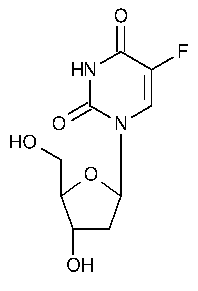Floxuridine
»Floxuridine contains not less than 98.5percent and not more than 101.0percent of C9H11FN2O5,calculated on the dried basis.
Change to read:
Packaging and storage—
Preserve in tight,light-resistant containers.
Labeling—
Where it is intended for use in preparing injectable dosage forms,the label states that it is sterile or must be subjected for further processing during the preparation of injectable dosage forms.
Identification—
A:
Infrared Absorption á197Mñ.
B:
Ultraviolet Absorption á197Uñ—
Solution:
20µg per mL.
Medium:
0.1Npotassium hydroxide.
Absorptivities at 268nm,calculated on the dried basis,do not differ by more than 3.0%.
C:
Dissolve about 200mg in 10mLof water,and add a few drops of bromine TS:the bromine color is discharged.
Melting range,Class Iá741ñ:
between 145 and 153
and 153 ,but the range between beginning and end of melting does not exceed 2
,but the range between beginning and end of melting does not exceed 2 .
.
Specific rotation á781Sñ:
between +36 and +39
and +39 .
.
Test solution:
10mg per mL,in water.
Loss on drying á731ñ—
Dry it in vacuum over silica gel at 60 for 4hours:it loses not more than 0.2%of its weight.
for 4hours:it loses not more than 0.2%of its weight.
Residue on ignition á281ñ:
not more than 0.1%.
Limit of fluoride ions—
[NOTE—Use plasticware throughout this test.]
pH5.25Buffer—
Dissolve 110g of sodium chloride and 1g of sodium citrate in 700mLof water in a 2000-mLvolumetric flask.Cautiously add 150g of sodium hydroxide,and dissolve with shaking.Cool to room temperature,and,while stirring,cautiously add 450mLof glacial acetic acid to the cooled solution.Cool,add 600mLof isopropyl alcohol,dilute with water to volume,and mix:the pHof this solution is between 5.0and 5.5.
Standard stock solution—
Transfer 221mg of sodium fluoride,previously dried at 150 for 4hours,to a 100-mLvolumetric flask,add about 20mLof water,and mix to dissolve.Add 1.0mLof sodium hydroxide solution (1in 2500),dilute with water to volume,and mix.Each mLof this solution contains 1mg of fluoride ions.Store in a tightly closed,plastic container.
for 4hours,to a 100-mLvolumetric flask,add about 20mLof water,and mix to dissolve.Add 1.0mLof sodium hydroxide solution (1in 2500),dilute with water to volume,and mix.Each mLof this solution contains 1mg of fluoride ions.Store in a tightly closed,plastic container.
Standard solutions—
Dilute portions of the Standard stock solutionquantitatively and stepwise with pH5.25Bufferto obtain 100-mLsolutions having concentrations of 1,3,5,and 10µg per mL.
Test solution—
Transfer 1.0g of Floxuridine to a 100-mLvolumetric flask,dissolve in and dilute with pH5.25Bufferto volume,and mix.
Procedure—
Concomitantly measure the potential (see Titrimetry á541ñ),in mV,of the Standard solutionsand the Test solution,with a pHmeter capable of a minimum reproducibility of ±0.2mV,equipped with a glass-sleeved calomel-fluoride specific-ion electrode system.[NOTE—When taking measurements,immerse the electrodes in the solution,which has been transferred to a 150-mLbeaker containing a polytef-coated stirring bar.Allow to stir on a magnetic stirrer having an insulated top until equilibrium is attained (1to 2minutes),and record the potential.Rinse and dry the electrodes between measurements,taking care to avoid damaging the crystal of the specific-ion electrode.]Plot the logarithm of the fluoride-ion concentrations,in µg per mL,of the Standard solutionsversus potential,in mV.From the measured potential of the Test solutionand the standard curve,determine the concentration,in µg per mL,of fluoride ions in the Test solution:not more than 0.05%is found.
Heavy metals,Method IIá231ñ:
0.002%.
Other requirements—
Where the label states that Floxuridine is sterile,it meets the requirements for Sterile Solidsunder Injections á1ñand for Pyrogenunder Floxuridine for Injection.Where the label states that Floxuridine must be subjected to further processing during the preparation of injectable dosage forms,it meets the requirements for Pyrogenunder Floxuridine for Injection.
Assay—
Dissolve about 800mg of Floxuridine,accurately weighed,in 80mLof dimethylformamide,and titrate with 0.1Ntetrabutylammonium hydroxide VS,determining the endpoint potentiometrically using a calomel-glass electrode system.Perform a blank determination,and make any necessary correction.Each mLof 0.1Ntetrabutylammonium hydroxide is equivalent to 24.62mg of C9H11FN2O5.
Auxiliary Information—
Staff Liaison:Behnam Davani,Ph.D.,MBA,Senior Scientist
Expert Committee:(PA7)Pharmaceutical Analysis 7
USP28–NF23Page 827
Pharmacopeial Forum:Volume No.29(6)Page 1886
Phone Number:1-301-816-8394
